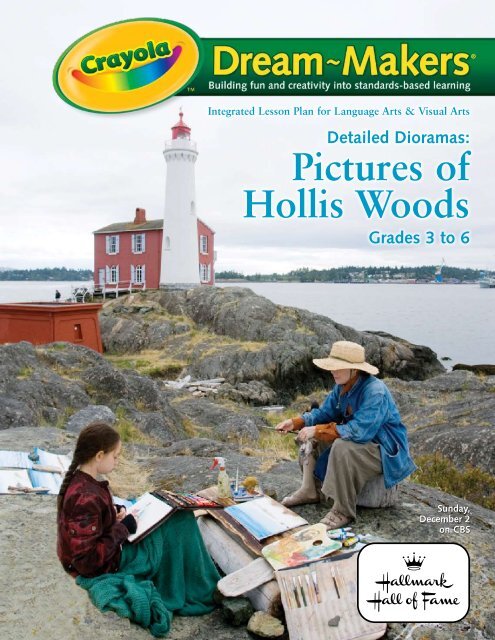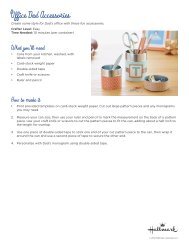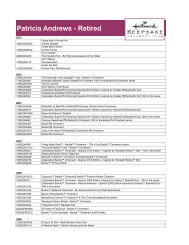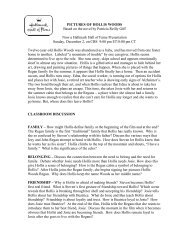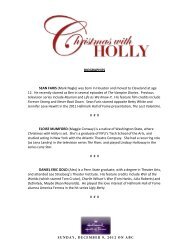Detailed Dioramas: Pictures of Hollis Woods - Hallmark
Detailed Dioramas: Pictures of Hollis Woods - Hallmark
Detailed Dioramas: Pictures of Hollis Woods - Hallmark
You also want an ePaper? Increase the reach of your titles
YUMPU automatically turns print PDFs into web optimized ePapers that Google loves.
Integrated Lesson Plan for Language Arts & Visual Arts<br />
<strong>Detailed</strong> <strong>Dioramas</strong>:<br />
<strong>Pictures</strong> <strong>of</strong><br />
<strong>Hollis</strong> <strong>Woods</strong><br />
Grades 3 to 6<br />
Sunday,<br />
December 2<br />
on CBS
<strong>Detailed</strong> <strong>Dioramas</strong>: <strong>Pictures</strong> <strong>of</strong> <strong>Hollis</strong> <strong>Woods</strong><br />
Objectives<br />
Students demonstrate their understanding <strong>of</strong> the relationships<br />
between graphic art and written text by working cooperatively in<br />
small groups to create detailed dioramas that show how Patricia<br />
Reilly Giff integrated characters and setting to develop a theme in<br />
<strong>Pictures</strong> <strong>of</strong> <strong>Hollis</strong> <strong>Woods</strong>.<br />
Students demonstrate the ability to draw meaningful conclusions<br />
about the connections between literature and life through discussions<br />
with other readers.<br />
Students (5-6) use elements <strong>of</strong> the writing process to describe and<br />
interpret a meaningful event from their own lives.<br />
Visual Arts Standard #6<br />
Making connections between visual<br />
arts and other disciplines<br />
Background Information<br />
Many folk artists draw inspiration from personal memories,<br />
painting scenes from their own lives in great detail. Grandma<br />
Moses (actually Anna Mary Robertson Moses 1860-1961) was<br />
one such artist. Her detailed paintings, such as Sugaring Off<br />
and Apple Pickers, recall bucolic New England activities. She<br />
was “discovered” when well into her seventies by an art<br />
collector who saw several <strong>of</strong> her paintings hanging in a<br />
drugstore window in Hoosic Falls, New York, in 1939. The<br />
Bennington Museum in Bennington, Vermont, houses a large<br />
collection <strong>of</strong> her work.<br />
In contrast to the personal scenes painted by Grandma<br />
Moses, Faith Ringgold painted from the collective memory<br />
<strong>of</strong> her African American roots. "Tar Beach," a painted story<br />
quilt, is on exhibit in the Brooklyn Museum in New York. It is<br />
also the basis for a children’s picture book by the same name<br />
which was published in 1991.<br />
Another art form artists use to preserve memories is the<br />
diorama. This is a life-like scene in which sculptures are set<br />
against a decorated background inside a box or concave shell.<br />
Some people liken them to set designs for the theater. While<br />
most dioramas are miniature, some are life size such as the<br />
well-known animal dioramas at the Museum <strong>of</strong> Natural History<br />
in New York and the vibrant street scenes by American pop<br />
artist, Red Grooms.<br />
2<br />
My Family<br />
Alison L., age 11<br />
<strong>Detailed</strong> <strong>Dioramas</strong>: <strong>Pictures</strong> <strong>of</strong> <strong>Hollis</strong> <strong>Woods</strong><br />
National Standards<br />
Multiple Intelligences<br />
Bodily-kinesthetic Linguistic<br />
Interpersonal Spatial<br />
Intrapersonal<br />
Linguistic<br />
Spatial<br />
Grades 3-6<br />
Language Arts Standard #2<br />
Students read a wide range <strong>of</strong> literature from many periods in many genres to build an<br />
understanding <strong>of</strong> the many dimensions (e.g., philosophical, ethical, aesthetic) <strong>of</strong> human<br />
experience.<br />
Language Arts Standard #11<br />
Students participate as knowledgeable, reflective, creative, and critical members <strong>of</strong> a variety<br />
<strong>of</strong> literacy communities.<br />
Grades 5-6<br />
Language Arts Standard #5<br />
Students employ a wide range <strong>of</strong> strategies as they write and use different writing process<br />
elements appropriately to communicate with different audiences for a variety <strong>of</strong> purposes.<br />
Resources<br />
The Great Gilly Hopkins by Katherine Patterson<br />
Eleven-year-old, “tough as nails” foster child, Gilly Hopkins,<br />
meets her match with foster mother Maime Trotter. In the<br />
process she gains an understanding <strong>of</strong> herself as well as <strong>of</strong> the<br />
very human characters who surround her.<br />
Tar Beach by Faith Ringgold<br />
The vibrant illustrations in this picture book are based on<br />
images in a story quilt by the artist. They depict detailed scenes<br />
from the life <strong>of</strong> a fictional Depression-era child enjoying family<br />
times on the ro<strong>of</strong> (tar beach) <strong>of</strong> her New York City apartment.<br />
The <strong>Pictures</strong> <strong>of</strong> <strong>Hollis</strong> <strong>Woods</strong> by Patricia Reilly Giff<br />
A warm-hearted story about 12-year-old <strong>Hollis</strong>, who is a talented<br />
artist in search <strong>of</strong> a family. Themes include creativity,<br />
diversity, acceptance <strong>of</strong> individual differences, aging, character<br />
development, the foster care system, and emotional maturity.<br />
The Year With Grandma Moses by W. Nikola-Lisa<br />
Elementary school students are fascinated by the details <strong>of</strong><br />
everyday life in these full-color reproductions <strong>of</strong> paintings<br />
by the artist known as Grandma Moses. Also included is a<br />
photograph <strong>of</strong> the artist at work and excerpts from her<br />
memoirs detailing the routines, pleasures, and disappointments<br />
<strong>of</strong> her life.<br />
Windows on Nature: The Great Habitat <strong>Dioramas</strong> <strong>of</strong><br />
the American Museum <strong>of</strong> Natural History by Stephen<br />
Christopher Quinn<br />
Written by a member <strong>of</strong> the American Museum <strong>of</strong> Natural<br />
History’s curatorial staff, this book introduces readers to more<br />
than 40 <strong>of</strong> the museum’s dioramas and <strong>of</strong>fers a detailed look at<br />
how they were created. Intriguing for all ages.<br />
Building fun and creativity into standards-based learning
<strong>Detailed</strong> <strong>Dioramas</strong>: <strong>Pictures</strong> <strong>of</strong> <strong>Hollis</strong> <strong>Woods</strong><br />
Vocabulary List<br />
• Art terms<br />
Armature<br />
Charcoal<br />
Composition<br />
• Literary terms<br />
Characterization<br />
Mood<br />
• Textual vocabulary<br />
Adoption<br />
Dollop<br />
Family<br />
Diorama<br />
Form<br />
Perspective<br />
Plot<br />
Forgetfulness<br />
Foster child/family<br />
Jetty<br />
Proportion<br />
Sculpt<br />
Setting<br />
Lingering<br />
Pier<br />
Runner<br />
Texture<br />
Whittle<br />
Theme<br />
Skittering<br />
Waders<br />
Building fun and creativity into standards-based learning<br />
<strong>Detailed</strong> <strong>Dioramas</strong>: <strong>Pictures</strong> <strong>of</strong> <strong>Hollis</strong> <strong>Woods</strong><br />
3
Suggested<br />
Preparation<br />
and<br />
Discussion<br />
Crayola ®<br />
Supplies<br />
Other<br />
Materials<br />
Set-up/Tips<br />
<strong>Detailed</strong> <strong>Dioramas</strong>: <strong>Pictures</strong> <strong>of</strong> <strong>Hollis</strong> <strong>Woods</strong><br />
Introduce the book <strong>Pictures</strong> <strong>of</strong> <strong>Hollis</strong> <strong>Woods</strong>. Read the story together or independently. Encourage students to<br />
visualize the richly detailed scenes.<br />
Ask students and their families to watch <strong>Pictures</strong> <strong>of</strong> <strong>Hollis</strong> <strong>Woods</strong> on the <strong>Hallmark</strong> Hall <strong>of</strong> Fame, Sunday<br />
December 2 at 9 p.m. EST on CBS television. The movie can also be purchased for screening in classrooms for<br />
later viewing or review.<br />
Display art work that focuses on details <strong>of</strong> everyday life, such as reproductions <strong>of</strong> paintings by Grandma Moses<br />
and Faith Ringgold, as well as sample dioramas.<br />
Discuss ways to preserve memories. How do we hold onto memories that are important to us?<br />
Discuss wishes and how they inspire us to seek fulfillment. What was <strong>Hollis</strong>’s wish? How did that wish affect<br />
her relationships with others? What was there about her experiences with the Reagans and Josie that changed<br />
her attitude?<br />
What did Beatrice mean in chapter four when she told <strong>Hollis</strong>, “You have to keep looking to see the truth”? What<br />
did <strong>Hollis</strong> later discover about the true relationship between Steven and his father when she looked back at some<br />
<strong>of</strong> the details in a picture she had drawn <strong>of</strong> them?<br />
Explain that students will be working together to create dioramas <strong>of</strong> various scenes from the book. Ask them to<br />
reread those portions <strong>of</strong> the book that they recall most vividly, noting the details provided by the author.<br />
• Colored Pencils • Crayons • Markers • Model Magic ® or Model Magic Fusion or Air-Dry Clay<br />
• School Glue<br />
• Chenille stems • Construction paper • Modeling tools such as plastic dinner knives, craft sticks, and toothpicks<br />
• Natural, found materials such as feathers, twigs, raffia, stones, leaves • Recycled items<br />
• Recycled cardboard boxes • Rulers • White paper<br />
Review the resources and use them as a springboard to find connections<br />
with student interests and experiences.<br />
Make a small-scale diorama to inspire children’s creativity. Collaborate<br />
with local writers, social workers, and artists in residence to add to the<br />
richness <strong>of</strong> the literacy and visual arts experience.<br />
Select boxes large enough to accommodate the work <strong>of</strong> several<br />
students. Boxes that contained 10 reams <strong>of</strong> paper are ideal.<br />
Collect small boxes, cardboard tubing, and clean, recycled<br />
plastic containers to use as armatures for the sculptures.<br />
Choose the modeling compound that is most suitable<br />
for the project. Model Magic is s<strong>of</strong>t, easy to manipulate,<br />
and light weight. Model Magic Fusion is ideal for<br />
projects with lots <strong>of</strong> detail and texture. Air-Dry<br />
Clay lends itself well to solid forms and can be<br />
painted when dry.<br />
Try working with the compound you plan<br />
to use. Show students how to knead Model<br />
Magic. Mix it a little for a marbled effect.<br />
Knead longer to create new colors.<br />
Demonstrate how to use armatures<br />
to support a figure covered with a<br />
thin layer <strong>of</strong> modeling compound.<br />
Use bold colors and a variety<br />
<strong>of</strong> craft materials for the most<br />
dramatic effects. Painting is<br />
another possibility.<br />
<strong>Detailed</strong> <strong>Dioramas</strong>: <strong>Pictures</strong> <strong>of</strong> <strong>Hollis</strong> <strong>Woods</strong><br />
Grades 3- Grades 5-6<br />
Family Fishing Tradition<br />
Mixed Media<br />
Artist: Julia Sefton<br />
Private Collection.<br />
Building fun and creativity into standards-based learning
Process:<br />
Session 1<br />
0-50 min.<br />
Process:<br />
Session 2<br />
0-50 min.<br />
(may be<br />
repeated)<br />
Process:<br />
Session 3<br />
0-50 min.<br />
Process:<br />
Session<br />
30- 0 min.<br />
Process:<br />
Session 5<br />
Grades 3-<br />
30- 0 min.<br />
Grades 5-6<br />
50-60 min.<br />
<strong>Detailed</strong> <strong>Dioramas</strong>: <strong>Pictures</strong> <strong>of</strong> <strong>Hollis</strong> <strong>Woods</strong><br />
Grades 3- Grades 5-6<br />
Plan the project<br />
1. Students form groups <strong>of</strong> 3 or 4 to discuss key scenes and select one to illustrate for their project.<br />
2. Work together to sketch the scene with colored pencils, much like <strong>Hollis</strong> created her pictures. Note specific<br />
details. What figures (both humans and objects) will be sculpted? Who will make each one?<br />
3. Choose large boxes for the dioramas. Discuss<br />
proportion as it relates to the figures and<br />
objects each student will make.<br />
3. Choose large boxes for the dioramas. Measure and<br />
calculate proportions and sizes <strong>of</strong> all figures and<br />
objects to be represented.<br />
Create figures<br />
. Students experiment briefly with the modeling compound and then create their sculptures as planned. Use<br />
modeling tools to add details and texture. Embed small beads, twigs, and other textural objects for added interest.<br />
Encourage students to strive for realism and accuracy in their creations.<br />
5. Store unfinished pieces and remaining modeling compound in plastic containers with lids. Fusion dries to the<br />
touch overnight and dries completely in 2 to 3 days.<br />
Design diorama setting<br />
6. Students collaborate to create backgrounds inside the box with paper, colored pencils, additional modeling compound,<br />
and other craft materials. Glue them to the inside walls <strong>of</strong> the box.<br />
7. Cover the outside <strong>of</strong> the box to create a polished<br />
presentation.<br />
7. Encourage students to think about the outside walls<br />
<strong>of</strong> the box, too, if appropriate. For example, students<br />
who create an interior house scene may wish to<br />
decorate the front panel <strong>of</strong> the box to look like the<br />
front porch.<br />
Assemble diorama<br />
8. Students work together to assemble their dioramas, paying attention to how various characters interact with<br />
each other and their positions in the environment. Consider overall composition. How can students make the<br />
scene aesthetically pleasing by looking at the effects <strong>of</strong> line, form, balance, unity, and movement?<br />
9. When groups are satisfied with the overall composition, glue figures securely in place. Air-dry the glue.<br />
Write explanatory text<br />
10. Groups determine titles for their dioramas.<br />
11. Prepare display cards with the title <strong>of</strong> the work,<br />
the names <strong>of</strong> the artists, and a brief explanation<br />
<strong>of</strong> the importance <strong>of</strong> the scene to the overall<br />
theme <strong>of</strong> the book.<br />
Write personal narratives<br />
10. Each group determines a title for their work and<br />
attaches a title card to the diorama that includes<br />
the names <strong>of</strong> the artists.<br />
11. Ask each student to envision a key scene from his<br />
or her own life. Write a short personal narrative<br />
including as many visual details as possible. Why<br />
is the memory <strong>of</strong> this scene important? Does the<br />
student have any new insights looking back on it<br />
now? Encourage those who want to display their<br />
writing to do so.<br />
12. Students share and explain their dioramas with the class. Arrange dioramas in chapter order. Discuss how well the<br />
dioramas portray the book’s settings and characters.<br />
Family Fresco<br />
Watercolors and Tempera Mixing Mediums<br />
Artist: Betsy Moerder<br />
Private Collection.<br />
Building fun and creativity into standards-based learning<br />
<strong>Detailed</strong> <strong>Dioramas</strong>: <strong>Pictures</strong> <strong>of</strong> <strong>Hollis</strong> <strong>Woods</strong><br />
5
Assessment<br />
Other Ideas<br />
and<br />
Extensions<br />
6<br />
<strong>Detailed</strong> <strong>Dioramas</strong>: <strong>Pictures</strong> <strong>of</strong> <strong>Hollis</strong> <strong>Woods</strong><br />
Did students work cooperatively to plan and create a diorama based on a scene from <strong>Pictures</strong> <strong>of</strong> <strong>Hollis</strong> <strong>Woods</strong>?<br />
Are the dioramas rich in details that accurately reflect descriptions in the book?<br />
Does each diorama reveal a sense <strong>of</strong> story and reflect relationships between characters? Are dioramas aesthetically<br />
pleasing?<br />
Ask students to reflect on this lesson and write a DREAM statement to summarize the most important things they<br />
learned and reflect on how they will use their knowledge. Suggest that they dream about exploring more ideas in<br />
the book and embellishing on the art techniques they learned.<br />
<strong>Detailed</strong> <strong>Dioramas</strong>: <strong>Pictures</strong> <strong>of</strong> <strong>Hollis</strong> <strong>Woods</strong><br />
Grades 3- Grades 5-6<br />
Do explanations clearly relate the scene to the theme<br />
<strong>of</strong> the book?<br />
Does student writing reflect an understanding <strong>of</strong><br />
the connections between life and literature?<br />
• After reading the book, fold paper in half. On the left side, sketch a favorite scene from the book. THEN watch<br />
the movie. Sketch that scene as it appeared in film. Discuss with students: How are the two settings alike? How<br />
are they different? Which intrigued your imaginations more—the book or the movie?<br />
• On maps <strong>of</strong> New York state, children locate geographic landmarks referred to in the story such as Long Island,<br />
Palisades Parkway, Route 17, Exit 90 (What town is there?), the town <strong>of</strong> Hancock, and the Delaware River.<br />
• Draw wishing pictures or make collages <strong>of</strong> wishes like those that introduce the story. Write essays describing why<br />
the wishes were chosen. What can students do to make their wishes come true?<br />
• Make tree figures much like those Josie carved, by shaping Model Magic ® Fusion around tree branches or other<br />
armatures. Create characters in the story (perhaps even one that shows how <strong>Hollis</strong> might have depicted Josie),<br />
self-portrait sculptures, or a representation <strong>of</strong> a family member. Encourage children to use the natural contours <strong>of</strong><br />
the branches for inspiration.<br />
• After watching the program, encourage families to read the book together. Compare and contrast the experiences<br />
in the two media.<br />
• Suggest that families do related art projects at home, such as working together on scrapbooks, making a diorama <strong>of</strong><br />
a memorable event in their lives, or sketching/sculpting a family portrait. See the following page for a handout.<br />
Adapt it to suit your classroom and homework assignments, sign it, and distribute it to families.<br />
• Explore Crayola.com for related activities such as Family Food Favorites, Here’s My Family, Intergenerational<br />
Interviews, Family Fireplace Fun, Family Fishing Tradition, and Family Fresco.<br />
Family Reunion<br />
Keith I., age 12<br />
• Encourage students who enjoyed recalling a special<br />
memory from their own lives to create an illustration<br />
similar to those <strong>Hollis</strong> drew in her sketchbook.<br />
• Draw pictures that depict predictions about <strong>Hollis</strong><br />
<strong>Woods</strong>’ future. Where will she be? What will she be<br />
doing? How did she get there?<br />
• Interview someone who works in the foster care system<br />
or who has been a foster family. How does <strong>Hollis</strong>’s story<br />
reflect real-life experience? How do families and social<br />
workers collaborate to resolve issues?<br />
Family Food Favorites<br />
Mixed media<br />
Artist: Susan Dobias<br />
Private Collection.<br />
Building fun and creativity into standards-based learning
Dear Families,<br />
Still Life in the Kitchen<br />
Vito Antoine M., age 10<br />
As part <strong>of</strong> our literacy and fine arts curriculum, our class is reading <strong>Pictures</strong> <strong>of</strong> <strong>Hollis</strong> <strong>Woods</strong> by<br />
Patricia Reilly Giff. A movie based on this award-winning book will be shown on the <strong>Hallmark</strong> Hall<br />
<strong>of</strong> Fame on Sunday December 2 at 9 p.m. EST on CBS television. We encourage you to watch<br />
the movie with your children—and read the book along with them, too!<br />
Small groups <strong>of</strong> children in our class are making dioramas <strong>of</strong> memorable scenes from the book.<br />
Ask your student which scene the group chose and talk about why it was picked. You might<br />
inquire about progress on the project in a day or two.<br />
After you see the show, we suggest that you follow up with some family activities like these to<br />
enhance your children’s language and visual arts skills. Everyone will enjoy the opportunity to<br />
reflect on this delightful and thought-provoking book!<br />
• Each family member could choose a picture described in the book. Sketch it the way <strong>Hollis</strong><br />
might have drawn it. Compare and contrast your sketches.<br />
• Make a 3-D diorama in a recycled box showing an unforgettable scene from the book/movie<br />
or from your own lives.<br />
• Draw, paint, sculpt, or photograph a family portrait. What will each <strong>of</strong> you wear? What will be<br />
in the background? Who will sit? Who will stand? How will the group be arranged?<br />
• Interview a family member or neighbor who is about the age <strong>of</strong> Josie. What is it like to be<br />
retired? To forget things sometimes? What hobbies keep the person active and interested in life?<br />
• Take a few minutes for each family member to remember a person who has been a life-long<br />
influence. What was that person like? Why did she or he make such a difference?<br />
• Start a family scrapbook, on paper or on line, to capture some <strong>of</strong> your favorite times together.<br />
Fill it with pictures, mementoes, and lively captions!<br />
• What dreams does your family share? What dreams does each person have? How will you make<br />
your dreams come true?<br />
We hope you enjoy sharing the book and movie with each other. We’ll let you know when our<br />
dioramas are finished so you can visit our classroom to see the projects!<br />
© 2007 Crayola, LLC<br />
Easton, PA 18044-0431<br />
Sincerely,<br />
<strong>Detailed</strong> <strong>Dioramas</strong>: <strong>Pictures</strong> <strong>of</strong> <strong>Hollis</strong> <strong>Woods</strong> 7
8<br />
<strong>Detailed</strong> <strong>Dioramas</strong>: <strong>Pictures</strong> <strong>of</strong> <strong>Hollis</strong> <strong>Woods</strong><br />
Find out how much fun—and how creative—standards-based learning can be! These six Crayola<br />
Dream-Makers guides are meant for classroom teachers and art specialists K-6.<br />
Language Arts<br />
Students soar creatively with<br />
classroom-tested lessons that<br />
encourage reading, writing,<br />
storytelling, wordplay, and<br />
vocabulary learning. Based on<br />
the IRA/NCTE Standards for<br />
the English Language Arts.<br />
24 lessons, 104 pages,<br />
spiral-bound s<strong>of</strong>tcover<br />
Mathematics<br />
Exciting, real-world applications<br />
for mathematical concepts<br />
engage students in patterning,<br />
counting, estimating, collecting<br />
and organizing data, measuring,<br />
and scaling. Based on the<br />
NCTM Standards for School<br />
Mathematics.<br />
24 lessons, 104 pages,<br />
spiral-bound s<strong>of</strong>tcover<br />
Social Studies<br />
Students explore social studies<br />
topics in depth as they study<br />
advanced technologies, reflect<br />
on cultural differences, compare<br />
behavioral changes, and examine<br />
positive character traits. Based<br />
on NCSS Standards for Social<br />
Studies.<br />
24 lessons, 104 pages,<br />
spiral-bound s<strong>of</strong>tcover<br />
To learn more about how the Crayola Dream-Makers library can help you build fun and creativity<br />
into learning, and to receive a free lesson plan, visit www.Crayola.com/DreamMakers<br />
For more free arts-integrated lesson plan ideas, go to Crayola.com<br />
Principles <strong>of</strong> Art and Design<br />
Practical lessons in the basic<br />
principles <strong>of</strong> art and design help<br />
students learn more than creative<br />
expression—they provide essential<br />
communication skills in our visual<br />
world. Based on the NAEA<br />
National Visual Arts Standards.<br />
24 lessons, 104 pages,<br />
spiral-bound s<strong>of</strong>tcover<br />
After-School Programs<br />
Link learning to school curriculum<br />
with lessons that improve critical<br />
thinking, problem posing, problem<br />
solving, and decision making—all<br />
with focused activities that make<br />
the best use <strong>of</strong> time and the after-<br />
or before-school environment.<br />
24 lessons, 104 pages,<br />
spiral-bound s<strong>of</strong>tcover<br />
Science<br />
Explore science with engaging<br />
lessons in which children<br />
creatively measure, classify,<br />
identify, and observe. Based<br />
on the National Academy <strong>of</strong><br />
Sciences National Science<br />
Education Standards.<br />
24 lessons, 104 pages,<br />
spiral-bound s<strong>of</strong>tcover


